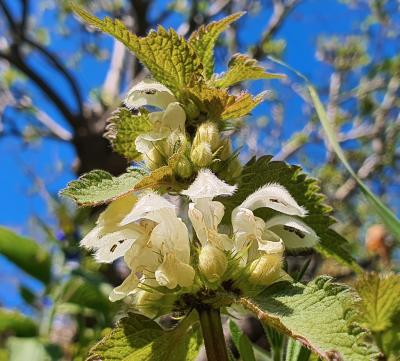White Dead-nettles are alive with insects
From March to December, this low-growing plant provides nectar to any insect that can navigate its strangely shaped flowers. And for those that can spot the difference between White Dead-nettles and Stinging Nettles, the leaves and stems are a fantastic feast.
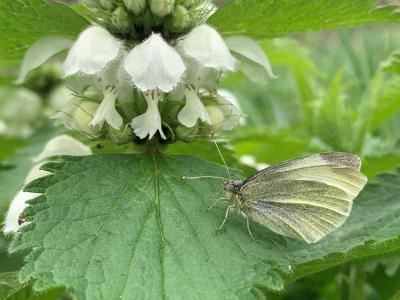
A Small White Butterfly sitting on a White Dead-nettle - Robin Hutchinson |
Spot the difference between White Dead-nettle and Stinging Nettles
White Dead-nettle look very similar to stinging nettles, but they are completely harmless. If you would like to complete a count on this plant, look out for the following features:
- White Dead-nettle are low growing, and can reach a maximum height of 60cm. Stinging Nettles, however, can get as tall as 150cm.
- Stinging Nettles have long hairs on their stems, whereas a White Dead-nettle will only have short hairs.
- White Dead-nettles have distinctive white flowers. The flowers have a large hood and a flat lower lip for insects to land on. The flowers are connected to the stems via a long white tube, called a corolla. Stinging Nettle flowers are much smaller and quite inconspicuous.
- White Dead-nettle flowers are positioned in a circle around the stem, while the flowers of Stinging Nettles are attached to tassels that droop away from the stem.
|
A close-up of a White Dead-nettle flower. The flowers' hoods have small black stamens hidden within them, which are covered in pollen - Martin Harvey |
What to look out for on a FIT count
White Dead-nettles use a variety of methods to attract pollinating insects. The flowers secrete essential oils and emit a lovely fragrance. Once an insect gets close enough, the yellowy green spots on the lower lip of the flower guide them in to land (Sulborska et al., 2014). This system is very successful for White Dead-nettles, with 626 insects counted over 128 FIT counts. This is an average of 5 insects seen in every count. There is some variation in this though, 20 counts did not record any insects, and the highest count recorded so far is 29 insects. It is really useful that this variation is recorded, because it allows us to monitor changes in insect populations.
If you complete a count on White Dead-nettle, you are likely to see a bumblebee. Bumblebees account for just under a third of all insects seen during FIT counts on dead nettles, by far the most common insect in this category. The long, narrow corolla of dead nettle flowers is difficult for many insects to navigate, but long-tongued bumblebees are perfectly equipped to reach down and access the nectar. Because of the flower’s shape, the bumblebees have to brush their backs against the stamens concealed within the flowers hood in order to drink the nectar. These stamens are covered in pollen, which the fluffy bumblebee will pick up and deliver to the next dead nettle flower they encounter.
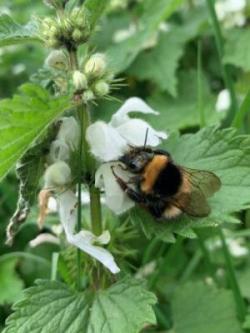
A Garden Bumblebee exploring a spike - Robin Hutchinson |
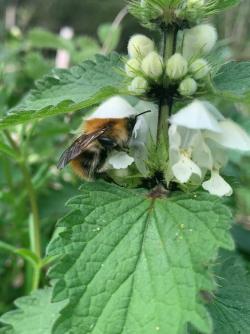
A Carder Bumblebee drinking from a flower - Robin Hutchinson |
Small insects are the second most common group to be seen in a White Dead-nettle FIT count, with 16% of insects seen during the FIT counts being under 3mm long. They benefit from being small enough to slip down the corolla, but some avoid the issue entirely by choosing to eat the freely-available pollen within the flower’s hood instead. This strategy is used by pollen beetles, a group of small, shiny insects that specialise in eating nutrient-rich pollen (UK Beetles, 2022).
There are also counts with insects whose tongues are too short to access the nectar through the intended method. Honeybee tongues are slightly shorter than the tongues of common bumblebee species, which means that it is more difficult for them to get to the nectar. Therefore, honeybees are not as common during White Dead-nettle FIT counts as counts on other plant species. Just 2% of insects counted on White Dead Nettle are honeybees. On the rare occasion that a honeybee tries to feed from White Dead-nettle, they may use a technique called “nectar robbing”. This involves going around the outside of the flower to the base, and making a small incision. The honeybee can then poke their tongue through this incision and drink the nectar (Potts, Breeze and Gemmill-Herren, 2014).
What about the leaves and stems?
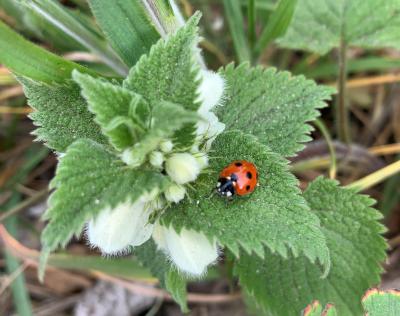
A Seven-spot Ladybird visits a White Dead-nettle plant while looking for aphids - Robin Hutchinson |
White Dead-nettles have evolved to mimic Stinging Nettles in order to protect themselves, but there are still plenty of insects that can see through this. Some insects grow up inside the plant’s leaves, eating the tissues as they move about. This results in characteristic trails and blotches, which can be used to identify the insect that created them. If you look closely, you might even see the pupa attached to the stem near the base of a leaf (UK Fly Mines, 2022). Other insects feed on the plant from the outside; aphids pierce the stem to suck out the sap, and caterpillars tuck in to the leaves (Biological Records Centre, 2022). You might see adult butterflies and moths laying their eggs on White Dead-nettle, so that when the caterpillars emerge they will have the perfect food source ready and waiting. The aphids and caterpillars then attract beneficial insects such as ladybirds and wasps, who will benefit from the abundance of insects that call White Dead-nettle their home.
Get counting!
There is plenty to see in your local White Dead-nettle patch, so why not complete a FIT count and see what you can find? Remember to record your results on the FIT count app or website so that we can find out how our pollinator populations are faring!
References
- Potts, S., Breeze, T., and Gemmill-Herren, B (2014). Crop Pollination. In: Encyclopedia of Agriculture and Food Systems, edited by Van Alfen, 408-418. ISBN: 978-0-08-093139-5
- Balfour, N.J., Garbuzov, M. and Ratnieks, F.L. (2013). Longer tongues and swifter handling: why do more bumble bees (Bombus spp.) than honey bees (Apis mellifera) forage on lavender (Lavandula spp.)?. Ecological Entomology, 38: 323-329. DOI: 10.1111/een.12019 https://resjournals.onlinelibrary.wiley.com/doi/10.1111/een.12019 Accessed 27 April 2022
- Biological Records Centre. dbif.brc.ac.uk. Accessed 19 April 2022.
- Sulborska, A., Dmitruk, M., Konarska, A., & Weryszko-Chmielewska, E. (2014). Adaptations of Lamium album L. flowers to pollination by Apoidea. Acta Scientiarum Polonorum Hortorum Cultus, 13(6), 31-43. ISSN: 1644-0692
- UK Beetles. https://www.ukbeetles.co.uk/nitidulidae Accessed 19 April 2022.
- UK Fly Mines. http://www.ukflymines.co.uk/Keys/LAMIUM.php Accessed 19 April 2022


